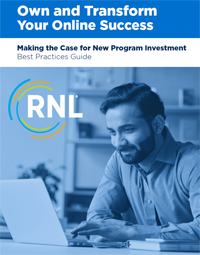enrollment
Making the Case for New Academic Program Investment
Institutions all over the country are giving much thought and time to “diversifying” their program portfolio as the traditional undergraduate market continues to encounter disruption. This is leading many institutions to consider new online (and graduate) programs.
But as budgets tighten, the approval process is going beyond making an academic case to the provost. In many cases, program advocates are being asked to make a quantitative, market-driven case to the CFO. Speaking the analytical “language” of your CFO can be quite a different task and RNL recently presented a webinar on how to do this.
We also published Making the Case for New Program Investment Best Practices Guide to provide a step-by-step approach for people preparing new program proposals. Here’s a recap of our webinar discussion:
Download the Best Practices Guide and watch the full webinar.
Critical elements of successful academic program planning
- Market Research: Underpin program selection with objective market data and insights.
- Program Design: Engage the right faculty/instructional designers to create program structures that reflect instructional best practices and student expectations.
- Program Development: Invest in the right learning experience to improve student satisfaction and success.
- Enrollment Planning: Set realistic enrollment expectations based on the available marketing investment, process constraints, and operational strategies.
In order to make a business case, these elements need to be presented in formats in which financial leaders regularly evaluate expenses and make decisions. In the guide we discuss in detail, each of the following steps:
- Build a reverse funnel spreadsheet to determine what your marketing investment will have to be. A “reverse funnel” implies that you start with the end in mind: your enrollment goals for the program. The guide provides specific steps and samples.
- Write an academic business plan: This differs from the regular academic plan which includes program objectives, outcomes, course descriptions, etc. This focuses on the business side of the program proposal, and included a number of standard components. The guide provides specific steps and samples.
- Develop the pro forma: Use your reverse funnel spreadsheet as the beginning point to prepare a spreadsheet that projects both targeted enrollment and accompanying budget several years out. This is a predictive model. The guide provides specific steps and samples.
Download the guide and contact us for a discussion
Our free Best Practices Guide provides a step-by-step approach to making the case for new program investment to fit your strategic planning process. You can also download additional guides from our Own and Transform Your Enrollment Series.
If you’d like to talk with an RNL expert about any of the details related to making the case for new program investment, contact us to set up a discussion with you and your team.

